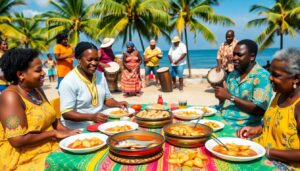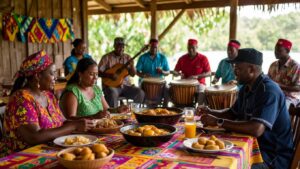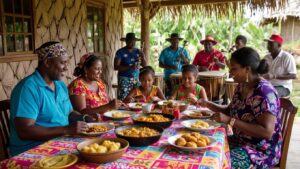Discover the Rich Tapestry of Garifuna Culture in Belize: An Immersive Exploration of Heritage, Cuisine, and Memorable Experiences
The Garifuna community in Belize epitomises a vibrant fusion of African, Indigenous Caribbean, and European cultural influences, culminating in a unique cultural heritage that has earned international acclaim and recognition from UNESCO. Their profound traditions encompass various aspects, including language, music, culinary arts, dance, spirituality, and a strong sense of community. This insightful guide invites you to delve into the captivating narrative of the Garifuna in Belize, highlighting their history, traditions, festivals, and the bustling cultural heart of Hopkins Village.
Explore the Depths of Garifuna Heritage and Identity
The Garifuna represent a prominent cultural group in Belize, with ancestral roots linking back to West and Central African forebears alongside the Indigenous Caribs and Arawaks. Their remarkable journey began with a courageous stand against colonial forces in St. Vincent in 1797, resulting in their forced relocation to Central America. Presently, approximately 30,000 Garifuna individuals reside in Belize, substantially enhancing the cultural fabric of southern Belize through their distinct language, exquisite cuisine, lively art, and treasured customs. Acknowledged by UNESCO as a Masterpiece of the Oral and Intangible Heritage of Humanity, their unwavering spirit, creativity, and resourcefulness continue to thrive in communities like Dangriga, Hopkins, Seine Bight, and Punta Gorda, as well as in diaspora populations across the Americas. The annual observance of Garifuna Settlement Day on November 19th stands as a powerful tribute to their legacy of resilience, unity, and rich cultural practices.

Delving into the Historical Foundations of the Garifuna Community
Mapping the Ancestry of African and Carib Heritage
The narrative of the Garifuna people has its origins in the 17th century, marking the remarkable union of African survivors from two Spanish slave ships and the Indigenous Carib and Arawak inhabitants of St. Vincent in the Lesser Antilles. Over a span of more than 150 years, intermarriage and cultural exchanges created a unique Afro-Indigenous identity known as the Garinagu. This identity is characterised by a rich tapestry of traditions, languages, and practices that vividly embody their diverse ancestral origins, showcasing the beauty and depth of their cultural heritage.
Forced Exile and New Beginnings in Belize's Cultural Heart
In 1797, after a resolute resistance against British colonial forces, around 5,000 Garifuna were forcibly exiled from St. Vincent to Roatán, Honduras. This critical juncture sparked migrations that extended along the Central American coast. By the early 19th century, vibrant Garifuna communities had flourished in southern Belize, particularly in culturally rich areas like Dangriga, often referred to as the cultural capital, alongside Hopkins, Seine Bight, and Barranco. The British authorities endorsed these migrations, aiming to attract skilled labourers proficient in fishing and agriculture, thereby fostering the growth of these communities.
Upholding Cultural Identity Amidst Adversity
Despite the myriad challenges posed by European colonisation, land dispossession, and systemic discrimination, the Garifuna have successfully preserved their language, social structures, and rich spiritual traditions. The establishment of the National Garifuna Council in 1981 has played a crucial role in advocating for cultural rights and educational initiatives, ensuring that the Garifuna heritage is celebrated and recognised widely both locally and internationally.
Language and Identity: The Foundations of Garifuna Culture
The Unique Characteristics of the Garifuna Language
The Garifuna language is a distinctive Arawakan tongue, notable for its incorporation of Carib and African loanwords, rendering it a remarkable case among Central American languages. It possesses gendered pronouns, a complex tense system, and a rich repository of oral traditions that articulate the community's history and cultural values. However, the survival of the Garifuna language faces significant threats due to a language shift spurred by migration and urbanisation, with fewer than 15,000 Belizean Garifuna individuals remaining fully fluent, underscoring the urgent necessity for revitalisation efforts.
Revitalising and Preserving Linguistic Heritage
The recognition of the Garifuna language and music as an Intangible Heritage by UNESCO in 2001 has catalysed revitalisation initiatives. In communities such as Hopkins and Dangriga, primary schools have begun offering educational programmes in Garifuna, while community radio stations broadcast music and news in the language, fostering its continuity. Organisations like GAMAE International have initiated language immersion summer camps designed to reconnect youth with their ancestral roots and linguistic heritage, ensuring the transmission of culture across generations and safeguarding their vibrant identity.
Expressions of Identity and Global Connections in the Diaspora
The Garifuna identity is reinforced through traditional attire, ancestral lineages, clan totems, and unique naming conventions. This identity is actively nurtured by cultural associations both within Belize and in diaspora communities located in major cities such as New York, Los Angeles, and London, where they continue to celebrate their rich heritage and cultural legacy with pride and fervour.
The Vibrant World of Garifuna Music and Dance
The Spiritual Significance of Rhythmic Drumming
Garifuna music is celebrated for its intricate rhythmic patterns, seamlessly blending traditional African polyrhythms with indigenous chants. Central to numerous spiritual rituals and celebratory events, the drums—specifically the primero (tenor) and segunda (bass)—are indispensable. The sacred dugú ceremony, for instance, incorporates drum circles and ancestral invocations aimed at healing or blessing families, illustrating the profound connection between music and spirituality that permeates Garifuna culture and enriches their communal life.
The Dynamic Dance Forms of Punta and Punta Rock
One of the most celebrated Garifuna dance styles is the punta, characterised by rapid hip movements and intricate footwork, frequently accompanied by call-and-response singing and vibrant percussion. The contemporary evolution of this dance form, known as punta rock, has been popularised by renowned musicians such as Andy Palacio and Pen Cayetano, who merge traditional rhythms with modern instrumentation, thus helping to disseminate Garifuna culture to audiences globally and fostering a greater appreciation for their artistic expressions.
Cultural Festivals that Showcase Community Spirit
In the lively towns of Hopkins and Dangriga, dance troupes frequently perform during cultural festivals and for visiting tourists, creating a living bridge between generations. These performances not only honour Garifuna heritage but also represent a vital economic resource for the community, fostering tourism and cultural exchange while enriching the local economy through the celebration of their unique cultural identity.

Examining the Cultural Practices and Spiritual Beliefs of the Garifuna
The Significance of the Dugú Ceremony in Garifuna Spirituality
The dugú ceremony is an elaborate multi-day event where extended families convene to honour the spirits of their ancestors, known as gubida. Led by a spiritual healer, or buyei, the ceremony incorporates music, dance, and communal feasting, all aimed at restoring harmony within families and the wider community. It underscores the deep respect for the land, ancestral heritage, and shared responsibilities that bind the community together, reinforcing their cultural identity.
Everyday Spiritual Practices Influencing Garifuna Life
The spiritual beliefs of the Garifuna represent a unique amalgamation of Catholicism along with elements drawn from African and Arawak cosmologies. Daily life is intertwined with various rituals, including blessings for new structures, rites of passage for births and deaths, and agricultural celebrations. Significant symbols, such as the conch shell, sea turtle, and cassava, serve as vital connections between households, the natural environment, and ancestral spirits, weaving a rich tapestry of meaning into their everyday existence and cultural practices.
Discovering the Culinary Delights of Garifuna Gastronomy
A Taste of Signature Dishes and Culinary Staples
The culinary artistry of Garifuna culture is deeply rooted in staples such as cassava (also known as yuca), plantains, coconut, and fresh seafood. Among their traditional offerings, ereba stands out as a cassava bread crafted from grated cassava that is pressed and toasted over an open flame. Another signature dish, hudut, features fish simmered in creamy coconut milk and served alongside mashed green and ripe plantains. Additionally, machuca, a hearty fish soup that includes garlicky, mashed plantain dumplings, and tapou, a savoury seafood stew enriched with coconut milk, are also beloved culinary treasures. In bustling street markets in Hopkins and Dangriga, visitors can indulge in local delights such as cassava pone (a sweet cake), fried plantain balls (known as ganún), and refreshing conch ceviche, showcasing the diverse culinary heritage of this remarkable culture.
Encouraging Sustainable Culinary Practices within the Community
Traditional Garifuna methods, including seasonal fishing, shellfish gathering, and small-scale gardening, promote ecological stewardship and sustainability. These practices are guided by cultural taboos and communal resource management principles, reflecting their deep connection to the environment. Culinary festivals hosted in Hopkins feature cooking contests and food tours orchestrated by women’s cooperatives, ensuring the preservation of cherished recipes and culinary techniques while actively engaging visitors in the rich gastronomic heritage of the Garifuna.
Hopkins Village: The Vibrant Heartbeat of Garifuna Culture
Historical Context and Cultural Relevance of Hopkins
Established in the early 1800s and known as Yarumein in Garifuna, Hopkins is nestled along the breathtaking Stann Creek coast. It serves as a vital hub for the Garifuna language, music, and crafts, embodying the rich cultural legacy of the community and acting as a beacon for cultural preservation and promotion.
Essential Experiences to Uncover in Hopkins Village
- Drum Circles: Participate in daily drum schools and enjoy nightly drum circles at local cultural centres.
- Garifuna Museum: Explore artefacts, oral histories, and photographic archives that delve into their migration, language, and music.
- Homestays and Workshops: Connect with local families who offer cooking lessons, fishing trips, and demonstrations of cassava bread preparation, providing an immersive cultural experience.
Annual cultural events in Hopkins, particularly the youth pageants during Garifuna Settlement Day, establish the village as an authentic gateway to experiencing the intricate cultural tapestry of Garifuna Belize, inviting visitors to engage with and appreciate their vibrant heritage.
The Economic Significance of Cultural Tourism in Hopkins
Cultural tourism plays a vital role in Hopkins, supporting over 75% of local households through guest accommodations, handicrafts, music classes, and guided tours. The headquarters of the National Garifuna Council orchestrates regional festivals and advocacy initiatives, ensuring that Garifuna culture remains vibrant and visible on the global stage, thus contributing to the sustainability of their cultural practices.
Celebrating Garifuna Settlement Day: A Cultural Commemoration
The Historical Significance of Garifuna Settlement Day
Observed each November 19 since 1941 and officially recognised since 1977, Garifuna Settlement Day commemorates the historic arrival of Garifuna ancestors in Belize by canoe in 1802. The reenactment procession, known as Yurumein, sees villagers arriving ashore carrying drums, cassava, and crops, accompanied by joyful singing and prayer, symbolising their enduring legacy and deep connection to their roots.
Modern Celebrations and Festive Activities
The festivities surrounding Garifuna Settlement Day beautifully intertwine sacred and secular elements, featuring nightlong dugú ceremonies and all-day drumming in churches and community squares. Processions adorned in traditional regalia, lively parades, dance performances, and food fairs enrich the day’s significance. National broadcasts, media features, and diaspora celebrations in major US cities attract visitors from across Belize and beyond, enhancing awareness and appreciation for Garifuna cultural traditions and their contributions to the multicultural fabric of Belize.
Confronting Contemporary Challenges and Sustaining Cultural Heritage
The Pressing Challenge of Language Shift Among Younger Generations
Language shift poses a significant challenge for the Garifuna community, as many young individuals, particularly in urban settings, increasingly prefer English or Kriol at home. Recognising this concerning trend, UNESCO has urged schools and NGOs to implement language immersion programmes, radio broadcasts, and mentorship initiatives aimed at preserving linguistic heritage and cultural identity, ensuring the survival of the Garifuna language and fostering a sense of pride in their unique heritage.
Land Rights and Tourism Development: Navigating Complex Issues
The rapid expansion of tourism and real estate development in coastal regions such as Seine Bight and Hopkins poses a threat to the traditional landholdings of the Garifuna. Advocacy efforts spearheaded by the National Garifuna Council and collaborative NGOs focus on securing land rights, influencing urban planning, and ensuring that tourism revenues are distributed equitably among local families and communities, thereby protecting their cultural heritage and fostering sustainable development.
Engaging Youth Through Arts, Technology, and Diaspora Connections
Garifuna artists and musicians, both locally and within the diaspora, are actively recording music, documenting recipes, and preserving oral histories to create digital archives and virtual festivals. These innovative platforms are essential for fostering connections between the broader Garifuna community and younger generations, ensuring that their rich cultural heritage is upheld and celebrated in an evolving world.
Guidelines for Respectfully Engaging with Garifuna Culture
- Select accommodations in Hopkins, Dangriga, or Seine Bight, and arrange tours directly with Garifuna-owned businesses to support the local economy and community.
- Engage in a drum workshop, attend a Settlement Day celebration, or volunteer in local cultural preservation initiatives to immerse yourself in the rich cultural tapestry.
- Support women’s cooperatives by sampling traditional dishes or purchasing handcrafted items to promote sustainable livelihoods and economic empowerment within the community.
- Always respect local customs; seek permission before photographing individuals, and be considerate during rituals and ceremonies to honour their traditions.
- Learn a few basic phrases in the Garifuna language to demonstrate your respect and genuine interest in their culture, fostering meaningful interactions with community members.
The Garifuna culture in Belize encapsulates a vibrant tapestry of resilience, profound spirituality, infectious music, exquisite culinary offerings, and strong community ties. By visiting places like Hopkins or Dangriga, participating in local festivals, or immersing oneself in the rhythmic heartbeat of the drums, travellers are granted a unique opportunity to engage with a rich historical continuum where the past and present resonate harmoniously. Supporting businesses owned by the Garifuna, honouring their traditions, and celebrating the linguistic and culinary diversity of this remarkable culture are essential steps to ensure its survival and flourishing for generations to come.
References and Suggested Reading for Cultural Enthusiasts
- Language, Dance and Music of the Garifuna – UNESCO Intangible Heritage
- History Of The Garifuna People – Belize.com
- Garifuna people – Wikipedia
- Varner, G.R. “Native Status and Maya Identity in Belize.” Journal of Latin American Anthropology, 1998
- Lee, N.R. “Toledo Garifuna and Indigenous Rights.” Mesoamerican Research, 2022
- National Garifuna Council – Wikipedia
- The Garifuna Living Heritage – ICH NGO Forum, 2023
- Dinther, R. “Language Shift and Prestige: Garifuna in Hopkins.” Journal of Pidgin and Creole Languages, 2017
- Habinaha Garifuna Language Program
- Veal, T. “Africanisms in Garifuna Culture of Belize.” Cultural Anthropology, 2004
- National Geographic: Preserving Garifuna Identity Through Ritual
- Music In Africa: Punta Rock and Garifuna Music
- Hopkins Cultural Center Official Site
- Cultural Survival Quarterly: Maya Rainforest and Garifuna in Belize
- Belize Living Heritage: Rituals and Social Practices
- Texas A&M: Belizean Food Culture
- Love Your Belize: Hudut Recipe
- Global M&A Pages: Sustainable Fishing Cooperatives
- National Garifuna Council of Belize
- UN Sustainable Development Reports on Garifuna Cultural Tourism
- Ambergris Caye: Garifuna Settlement Day Celebrations
- Garifuna.com: Diaspora, Digital Storytelling, and Modern Initiatives
The Article Garifuna Culture in Belize: Heritage, Food & Where to Experience It appeared first on Belize Travel Guide
The Article Garifuna Culture: Experience Heritage and Cuisine in Belize Was Found On https://limitsofstrategy.com
The Article Garifuna Culture: Discover Belize’s Heritage and Cuisine found first on https://electroquench.com

